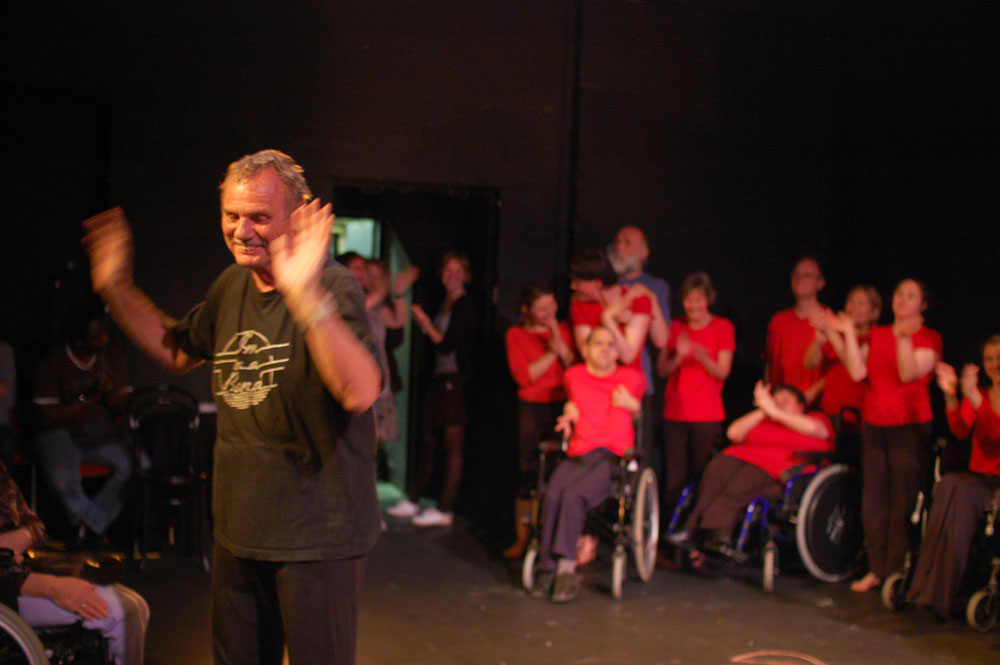
© Sheila Burnett. (Click image for larger version)
See the 40th Anniversary videos on YouTube
amicidance.org
For more background read Jann Parry’s earlier feature:
All about Amici and its director Wolfgang Stange
Wolfgang Stange, artistic director and founder of Amici Dance Theatre, had proudly announced forthcoming performances of the new show, One World, in May to celebrate the company’s fortieth anniversary, when the Covid-19 pandemic closed everything down. The show had been in preparation for nearly a year: participants from around the world had crowd-funded trips to London to take part in workshops, performances and the culminating production involving 80 people.
One World, with its subtitle The Wealth of the Common People, was postponed and replaced in May by nightly screenings of six previous productions from 1982 to 2015. (They are still available on YouTube.) Since 1999, Amici has been based at the Lyric Theatre Hammersmith, under the aegis of Turtle Key Arts as producers. Watching the recordings has been immensely nostalgic for Amici members, some of whom have been with the company from the start. But the videos are no substitute for live performances and cannot do the company justice.

© Sheila Burnett. (Click image for larger version)
This is because Amici (pronounced Ameeki) is an integrated company of disabled, differently-abled and able-bodied performers. In the theatre, what matters is the intensity of conviction the participants bring to every performance. They are not pretending to be the characters in the story but being them; they are not reproducing routines by rote but reimagining their original improvisations. Everyone believes in the messages each show conveys, or they wouldn’t be taking part. Although Stange has usually been credited as their choreographer over the years, others have contributed their own stories and ways of telling them.
Without foreknowledge of what it has taken to mount and perform a production, the result is hard to experience on screen. Early shows were not expertly filmed, so the action can be difficult to follow. The screened video of Rückblick, the 1982 production that made Amici’s reputation, is almost unwatchable in a 1995 recording of its revival, performed on tour in Berlin’s Akademie der Künste. Only if you’ve already seen the remarkable production (which I reviewed for The Observer in 1988) do its scenes cohere, recounting the life and work of the German artist Käthe Kollwitz. It’s a profoundly moving creation, with a beautiful duet at its heart for the woman in the role of the artist (Hilary Beard) and her Down’s syndrome son (Chris Collins). The Berlin recording doesn’t capture the right angles, but fortunately, a well-filmed account of their duet, by Martin Goodsmith, has been posted on YouTube:
Stange and early members of Amici have recalled memories of the first production of Rückblick in newsletters on Amici’s website: Newsletter 1, 2, 3, 4. When they first performed it at The Place in London, nobody appreciated how many people turned up to see it, nor what an impact it continued to have in future revivals. Critics who came to see Rückblick reviewed it and later productions by the same standards as for other theatrical performances. The tag on early publicity for a company of ‘handicapped and able-bodied performers’ was dropped, replaced simply by ‘dance theatre’.
As the duet from Rückblick reveals, Amici is primarily about dance as a means of expression. Stange started in 1980 giving dance classes for visually and mentally impaired participants, along with students of physio and psychotherapy. He was following in the footsteps of his mentor, the influential teacher Hilde Holger. He still begins every weekly class (under lockdown by Zoom) with a form of ballet warm-up. His way of creating has been to adapt improvisation ideas into themes for productions (rather as Pina Bausch did for her Tanztheater ‘pieces’), compiling them into a show that features the members’ special abilities. Not everyone is able to speak clearly but they can move to music.

© Turtle Key Arts. (Click image for larger version)
He began by using recorded music, then incorporated live musicians – cast members and professional collaborators – as well as commissioning scores. The millennial show, 20/20, was a musical history of disability in the 20th century, from maimed WWI soldiers to WWII concentration camp experiments, electric shock treatments and the polio epidemic (a precursor of today’s Corona virus pandemic). The score was by Billie Cowie, with contributions by Tchaikovsky, as the infant Aurora from The Sleeping Beauty turned out to have birth defects. Like the circus ‘freaks’ acts in Tightrope (2010), the guiding message was of acceptance and appreciation rather than pity or compassion.
The problem on screen is that visible disability isn’t subsumed by the performer’s personality, as it is in the theatre. The camera notices differences in appearance that a spectator soon learns to ignore. The tenderness between performers comes across in intimate sequences, with no distinction between their abilities, but the ensembles can be disconcerting: changes of tone from sincerity to irony and self-mockery are lost. Perhaps the most successful production on screen is the most recent: 35 Amici Drive, created for the company’s 35th anniversary. Well-filmed, with a clear story line and distinctive characters, it has powerful set pieces that work well on camera, more focused than in the theatre even. [dev-dancetabs.mystagingwebsite.com/2015/09/amici-dance-theatre-company-35-amici-drive-london/]
The six films in the 40th anniversary celebration provide tantalising glimpses of Amici’s considerable back catalogue, which includes short works as well as major productions. The company has had to fight for funding for its classes and workshops, as well as for its shows. It has even had to fight for its right to be an integrated company instead of consisting of disabled members only. Who can predict what the future might be for its continued existence as an exceptional dance theatre company? We can only hope that live theatre of all kinds will, eventually, return.

















You must be logged in to post a comment.